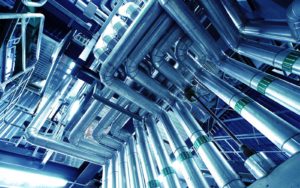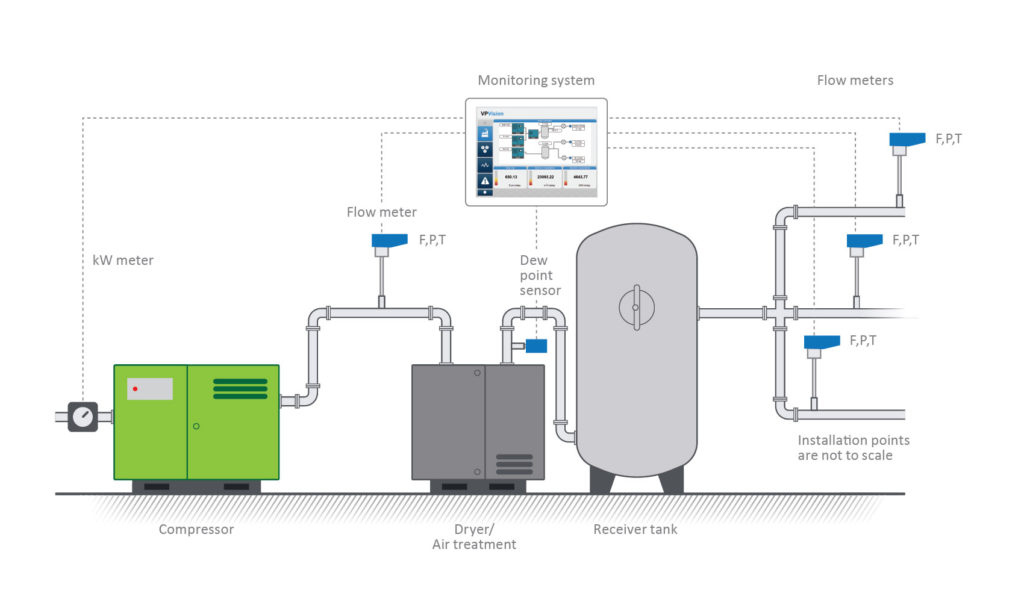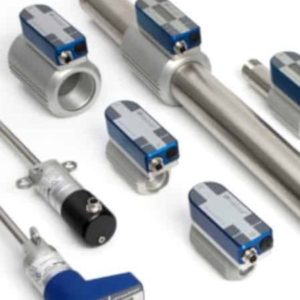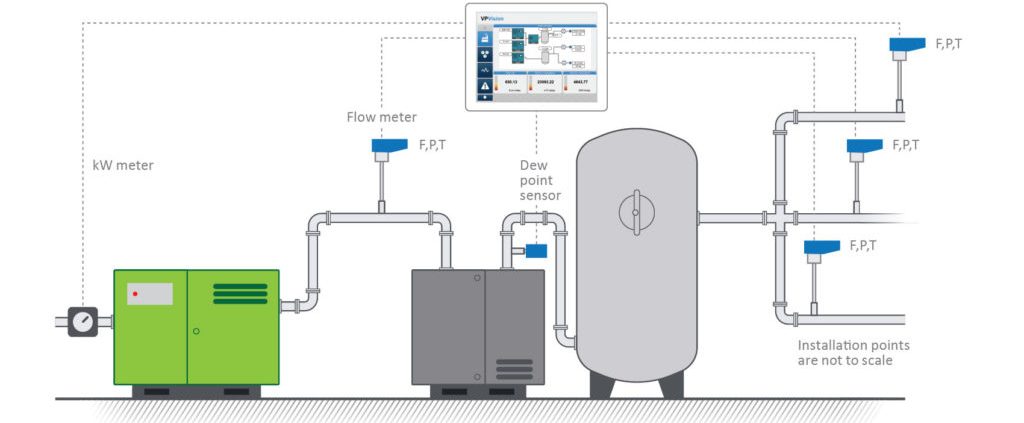Reduce energy costs with a compressed air flow meter
Consider the following situation. You find out you have been using way too much water at home. You discover a leaking gasket and there is water all over your basement. What is your course of action? Of course, it is to fix the leak right away. But what if this happened at your plant? And instead of water, we are dealing with compressed air? Probably nothing, because compressed air is “free” and the leak does not bother anyone because they remain invisible. This situation is not as hypothetical as you would think. Most factories make use of compressed air in their production process and leakages in the system are unfortunately common. Compared to electricity or gas, however, factories usually have little insight into their usage of compressed air.
It is crucial that you gain insight in your compressed air system. Because contrary to what some people think, air is not free at all. In an average production plant, compressed air costs are 10 to 30% of the electricity bill! That much money should not allow for leakages or an inefficient production process. Fortunately, there is an easy way to detect losses in your compressed air system. The solution: a compressed air flow meter. But how does this instrument work? And what does your company gain from it? Read it in this article.

Get four for the price of one
VPInstruments’ flow meters are 4-in-1: they measure bi-directional mass flow, temperature, pressure, and total flow. You need the complete picture to understand what is really going on. For example, a pressure drop can be caused by excessive flow through an undersized pipe, or air demand which exceeds compressor capacity. So, in order to understand (and solve) certain issues, you need the combination of these signals.
A sudden rise in temperature tells you something may be wrong with your compressed air drier. There is a risk of overheating in summer, especially, which can result in drier malfunction.
Information about the pressure level is important as well. It might be critical to maintain a steady pressure for your production process or to keep the pressure at a certain level. Just “to keep it safe”, this resulted in some cases in a higher pressure than really necessary. In those cases, it would be much better to eliminate the pressure fluctuations, which enables you to lower the overall pressure of the entire plant. As a rule of thumb, 1 bar lower pressure equals an energy savings of 7%!
But in order to optimize your production process, you first need to gain insight. You get just that by installing a four-in-one compressed air flow meter.
Gaining insight into your energy flow: not a pipe dream
First things first. What exactly is a compressed air flow meter? You can compare it to an electricity or gas meter. It shows how much energy is used (in this case compressed air). The flow meter is placed in a strategic place. For example, on the mainline, right where the compressed air enters the factory. Or at a department level, to measure how much air goes to a specific department. VPInstruments compressed air flow meters measure flow, pressure and temperature, and total flow at the same time, so you have a complete picture. With the display, you can have a direct reading, and the built-in data logger can store measurements for a longer period of time. In this way, you can analyze the data from the sensors and take action, if necessary. VPVision even gives you real-time insight into your energy flows, wherever you are.
Get to know your production process
No production process is the same. It is a long, winding route from the compressor to the production hall.


In most factories the system looks like this:
- It starts with a compressor room. This is the “energy plant” of the factory. This is often a place no one likes to visit because it is noisy and warm. However, it is worth a visit, because you will find a lot of savings opportunities.
- In the compressor room you will find one or more compressors. Take a look at their running hours and offload hours and their nameplates. Write down these numbers, and calculate the energy costs based on these numbers.
- After the compressors, you will find some filters and driers. With this equipment water is taken out of the compressed air. Why? Too much water is detrimental to the pipes and machines. Take a look at the floor: do you see water? In that case, you might have failing drains in the driers which need immediate action. Payback: 6 months.
- After the driers, you might find additional filters, for example, a particle filter, or a carbon filter, depending on the type of factory. Cleanliness and dryness are extremely important in the pharmaceutical and food industry, for example.
- After the filters, you probably find a “header” which distributes the air to various departments, the ‘demand’ side of the factory. This header is the ideal place to install flow meters for cost allocation and leakage monitoring.
- Through a myriad of pipes, the air will arrive at the machine it was intended for. Take a look at these pipes, sometimes they are full of surprises, like branches that were never put in a P& ID after the plant was built. One of these branches could go to a large consumer, which is causing pressure problems for the rest of the plant.
Airflow meter: information from the inside
At every aforementioned step in the production process, something can go haywire. This does not always need to be a big leak in the pipes (though it is certainly possible). There can also be smaller issues, like leaking compressed air drains, or excessive demand events. If your factory runs 24/7, however, all those issues add up to a lot of wasted air. It is basically money you throw away! It is impossible to detect the weak spots in your pipes by just looking at them on a daily basis. You do not have x-ray vision, after all, and you don’t have time to walk around all day. A flow meter, however, tells you everything you need to know and more.
By installing one or multiple flow meters at strategic places, you gain crucial information that will help you to set priorities and to back up your decisions with numbers. For example how much energy you use on weekdays and how much on weekends. Some factories discover to their surprise that compressed air is used on Sundays, even though their machines do not run that day. You can also compare one week of data to the next, using advanced monitoring software. In this way you might discover that an excessive leak has caused an increase of your baseline. This knowledge allows you to quickly take action. Imagine how many weak spots you can discover (and solve) thanks to a compressed air flow meter!
A flow meter for every situation
Your production process consists of many different steps, as previously explained. This calls for different types of flow meters. Fortunately, AirPro offers flow meters for every part of the compressed air system. From supply side to demand side. These flow meters are all part of the same “product family”, so the way to use them is mostly the same. They can each be used in different situations, however.
VPFlowScope DP is specially designed for wet and dirty compressed air flow measurement. When there is no need for such precautions, VPFlowScope M is a great choice. This flow meter is suited to measure dry compressed air and technical gases (after a drier). Our In-line flow meters, meanwhile, are built for small pipes up to 2”.




